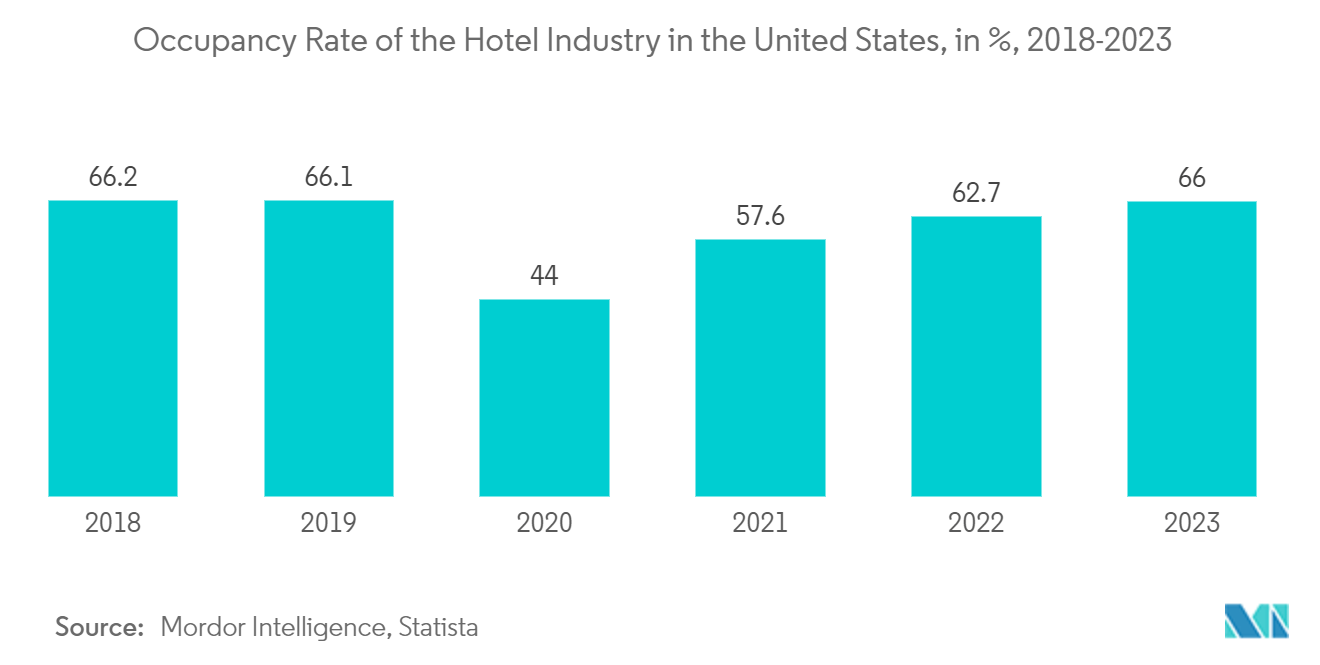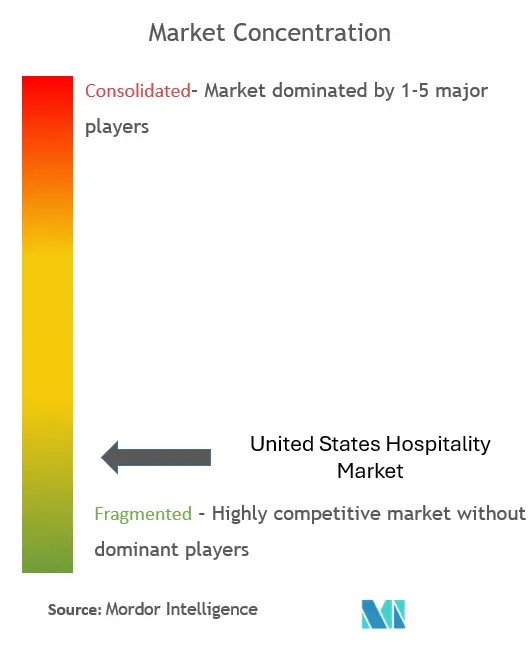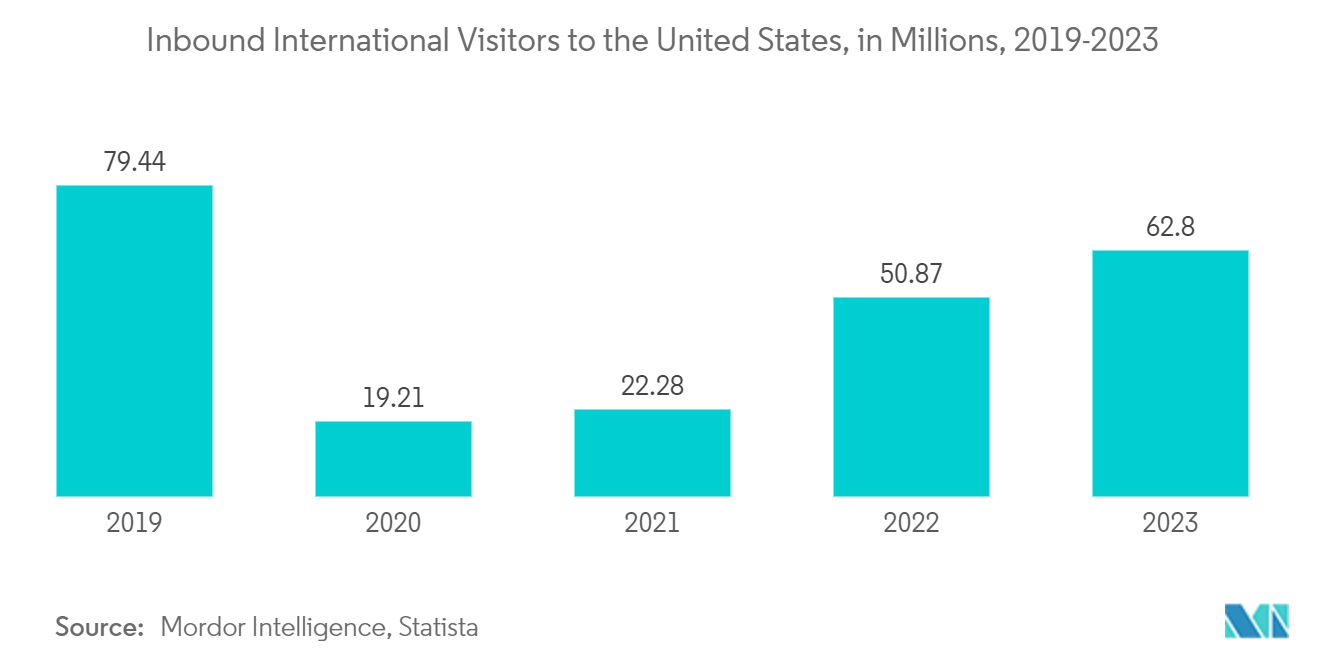
| Study Period | 2020 - 2030 |
| Base Year For Estimation | 2024 |
| Forecast Data Period | 2025 - 2030 |
| Market Size (2025) | USD 247.45 Billion |
| Market Size (2030) | USD 313.87 Billion |
| CAGR (2025 - 2030) | 4.87 % |
| Market Concentration | Low |
Major Players
*Disclaimer: Major Players sorted in no particular order |
United States Hospitality Market Analysis
The US Hospitality Market size is estimated at USD 247.45 billion in 2025, and is expected to reach USD 313.87 billion by 2030, at a CAGR of 4.87% during the forecast period (2025-2030).
The US hospitality industry encompasses diverse segments: lodging, F&B services, event planning, entertainment, and tourism. In recent years, the sector witnessed robust growth, buoyed by strong consumer spending, low unemployment, and a surge in domestic and international travel.
While leisure travel rebounded swiftly, business travel lagged, as consumers favored domestic locales and outdoor experiences. This preference shift shaped the recovery paths of hotels, resorts, vacation rentals, and outdoor recreational businesses. Technology emerged as a key driver, with digital platforms facilitating bookings, contactless payments, and elevating guest experiences. The F&B sector swiftly adapted to evolving consumer trends, placing a premium on off-premises options like takeout, delivery, and al fresco dining. Restaurants embraced technology, bolstering online ordering and contactless payment systems to prioritize customer safety and convenience.
US Hospitality Market Trends
US Hotel Occupancy Soars, Fueled by Diverse Factors and Economic Uptick
Multiple factors, such as business and leisure travel, events, and conventions, propelled the demand for hotel occupancy in the United States. Economic conditions, consumer confidence, and evolving travel patterns further influenced hotel occupancy growth. Following a strong performance in the previous year, the US hotel sector continued its upward trajectory this year. After several consecutive years of rising occupancy rates, many markets achieved record highs. Currently, the sector outperformed its performance in the previous year.
While weekday demand has shown improvement, leisure travel remains the primary catalyst for the industry's resurgence. New York, Las Vegas, Orlando, Los Angeles, Miami, and San Francisco stand out for their vibrant hotel markets. Higher occupancy rates often translate into increased revenue for hotels. As rooms fill, hotels can generate more income through room rates, additional services, and amenities. This revenue surge bolsters the hospitality market's overall growth and profitability.

US Hospitality Market Thrives on International Travelers' Surge
International travelers are pivotal in propelling the US hospitality market. Their presence fuels demand across various lodging options, spanning hotels, resorts, vacation rentals, and more. These travelers, whether for leisure or business, actively book accommodations, bolstering occupancy rates and revenue for the hospitality sector. Data from the UNWTO World Tourism Barometer reveals a significant surge in foreign visitor visits this year, a nearly fourfold increase from January to July (+172% YoY). This surge has propelled the industry close to its pre-pandemic levels, primarily attributed to a robust international travel demand and the ease of travel restrictions.
The tourism sector, a critical economic expansion and employment factor, has consistently grown and diversified over the past decades. It is now one of the world's largest and fastest-growing economic sectors. The US bolsters its global appeal as a premier travel destination by attracting international travelers. Positive experiences and word-of-mouth endorsements from these visitors further solidify the US's allure, paving the way for sustained growth in the hospitality industry.
United States Hospitality Industry Overview
The competitive landscape of the US hospitality industry is dynamic and diverse, with numerous players competing across various sectors. The industry is further influenced by emerging trends such as the rise of alternative lodging options (e.g., Airbnb), the integration of technology to enhance guest experiences, sustainability initiatives, and changing consumer preferences for personalized and unique travel experiences. Marriott International, Hilton Worldwide Holdings, InterContinental Hotels Group (IHG), Choice Hotels International Inc., and Wyndham Hotels & Resorts are significant players in the US hospitality industry.
United States Hospitality Market Leaders
-
Marriott International
-
Hilton Worldwide
-
Wyndham Hotels & Resorts
-
InterContinental Hotels Group (IHG)
-
Choice Hotels International Inc.
- *Disclaimer: Major Players sorted in no particular order

United States Hospitality Market News
- September 2023: IHG Hotels & Resorts opened a new Holiday Inn property in South Philadelphia following a conversion and renovation. Located minutes from Philadelphia International Airport and within walking distance of the city’s primary sports and entertainment facilities complex (which includes Lincoln Financial Field, Citizens Bank Park, and Wells Fargo Center), Holiday Inn Philadelphia Airport Stadium Area delivers a convenient, comfortable, and welcoming experience appropriate for the “City of Brotherly Love.”
- August 2023: Wyndham Hotels & Resorts and LuxUrban Hotels Inc., a leading hotel operator with a growing portfolio of nearly two dozen assets in key urban markets across the United States, announced a newly signed deal to bring 16 LuxUrban hotels, representing approximately 1,400 rooms, into the Trademark Collection by Wyndham brand.
United States Hospitality Industry Segmentation
The hospitality industry encompasses businesses and establishments primarily providing accommodation, food and beverage services, entertainment, event planning, and other related services to travelers, tourists, and local patrons. The US hospitality industry is segmented by type and segment. By type, the market is segmented into chain hotels and independent hotels. The market is segmented into service apartments, budget, and economy hotels, mid and upper-mid-scale hotels, and luxury hotels. The report offers market size and forecasts for the US hospitality industry in value (USD) for all the above segments.
| By Type | Chain Hotels |
| Independent Hotels | |
| By Segment | Service Apartments |
| Budget and Economy Hotels | |
| Mid and Upper Mid-Scale Hotels | |
| Luxury Hotels |
US Hospitality Market Research Faqs
How big is the US Hospitality Market?
The US Hospitality Market size is expected to reach USD 247.45 billion in 2025 and grow at a CAGR of 4.87% to reach USD 313.87 billion by 2030.
What is the current US Hospitality Market size?
In 2025, the US Hospitality Market size is expected to reach USD 247.45 billion.
Who are the key players in US Hospitality Market?
Marriott International, Hilton Worldwide, Wyndham Hotels & Resorts, InterContinental Hotels Group (IHG) and Choice Hotels International Inc. are the major companies operating in the US Hospitality Market.
What years does this US Hospitality Market cover, and what was the market size in 2024?
In 2024, the US Hospitality Market size was estimated at USD 235.40 billion. The report covers the US Hospitality Market historical market size for years: 2020, 2021, 2022, 2023 and 2024. The report also forecasts the US Hospitality Market size for years: 2025, 2026, 2027, 2028, 2029 and 2030.
Our Best Selling Reports
US Hospitality Industry Report
The United States hospitality market is experiencing significant growth, driven by diverse factors across its segments including accommodation, food and beverage services, entertainment, and tourism. This industry plays a vital role in the nation's economy by providing substantial employment opportunities and contributing to the GDP. The market caters to a wide range of needs from business and leisure travelers to group and long-term stay travelers, with key segments including hotels, motels, resorts, vacation rentals, and bed and breakfasts. These segments offer services ranging from full-service to budget options. The expansion of the market is fueled by increasing disposable incomes, a thriving tourism sector, and technological advancements that enhance guest experiences. However, it faces challenges such as labor shortages, regulatory hurdles, and seasonal fluctuations. Despite these obstacles, the market is poised for robust growth, leveraging technology and innovative service offerings to meet the evolving preferences of modern travelers. For detailed statistics, market share, size, and revenue growth rate, refer to industry reports by Mordor Intelligence™, which include market forecasts, outlooks, and historical overviews available as free report PDF downloads. Key trends in the hotel industry and the performance of hospitality companies in the USA further underscore the dynamic nature of this sector.





